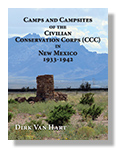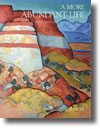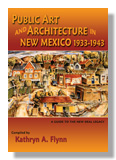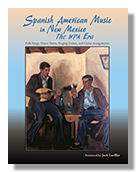 CAMPS AND CAMPSITES OF THE CIVILIAN CONSERVATION CORPS (CCC) IN NEW MEXICO 1933–1942
CAMPS AND CAMPSITES OF THE CIVILIAN CONSERVATION CORPS (CCC) IN NEW MEXICO 1933–1942By Dirk Van Hart
The impact of the Civilian Conservation Corps (CCC) on New Mexico is often forgotten, mainly because the subsequent cataclysm of World War II erased it from the public’s consciousness. This book is designed to document the state’s ninety CCC sites (camps) where 55,000 young men (including 32,000 state residents) actually worked and lived during the grim Great Depression of the 1930s. The impact of the CCC on the state and the nation is incalculable. This book details where the camps were located, how to recognize the sites today, and how to appreciate them in context.
Dirk Van Hart earned Bachelor’s and Master’s degrees in geology and began a professional career as a petroleum geologist in 1965. During the next two decades a gypsy life took him and his family to residences in Oklahoma, Texas, California, Guatemala, and Ecuador. In 1986 a career change brought him to Albuquerque, New Mexico. For the next seventeen years he worked as a geologist in Italy and Belize, and also for a short while as a student high-school teacher in Albuquerque, and as a contractor to Sandia National Laboratories working on characterization of the geology of Kirtland Air Force base. After semi-retirement in 2003 he worked for five years as a geological consultant until final retirement. In 1998 he began his twenty-year affiliation with New Mexico’s only alumni chapter of ex-CCC “boys” (as they were called), and was the chapter’s president for the last fifteen years. He learned firsthand about the CCC, its achievements, its men, and its enormous impact on the “Greatest Generation.” The “boys” are now all gone. This book is his tribute to them. Van Hart is also the author of Old New Mexico Route 44 from Sunstone Press.
Softcover:
Hardcover:
8.5 x 11
ISBN: 978-1-63293-339-3
278 pp.,$34.95
8.5 x 11
ISBN: 978-1-63293-294-5
278 pp.,$26.95
 A MORE ABUNDANT LIFE
A MORE ABUNDANT LIFE PUBLIC ART AND ARCHITECTURE IN NEW MEXICO, 1933-1943
PUBLIC ART AND ARCHITECTURE IN NEW MEXICO, 1933-1943 SPANISH AMERICAN MUSIC IN NEW MEXICO, THE WPA ERA
SPANISH AMERICAN MUSIC IN NEW MEXICO, THE WPA ERA